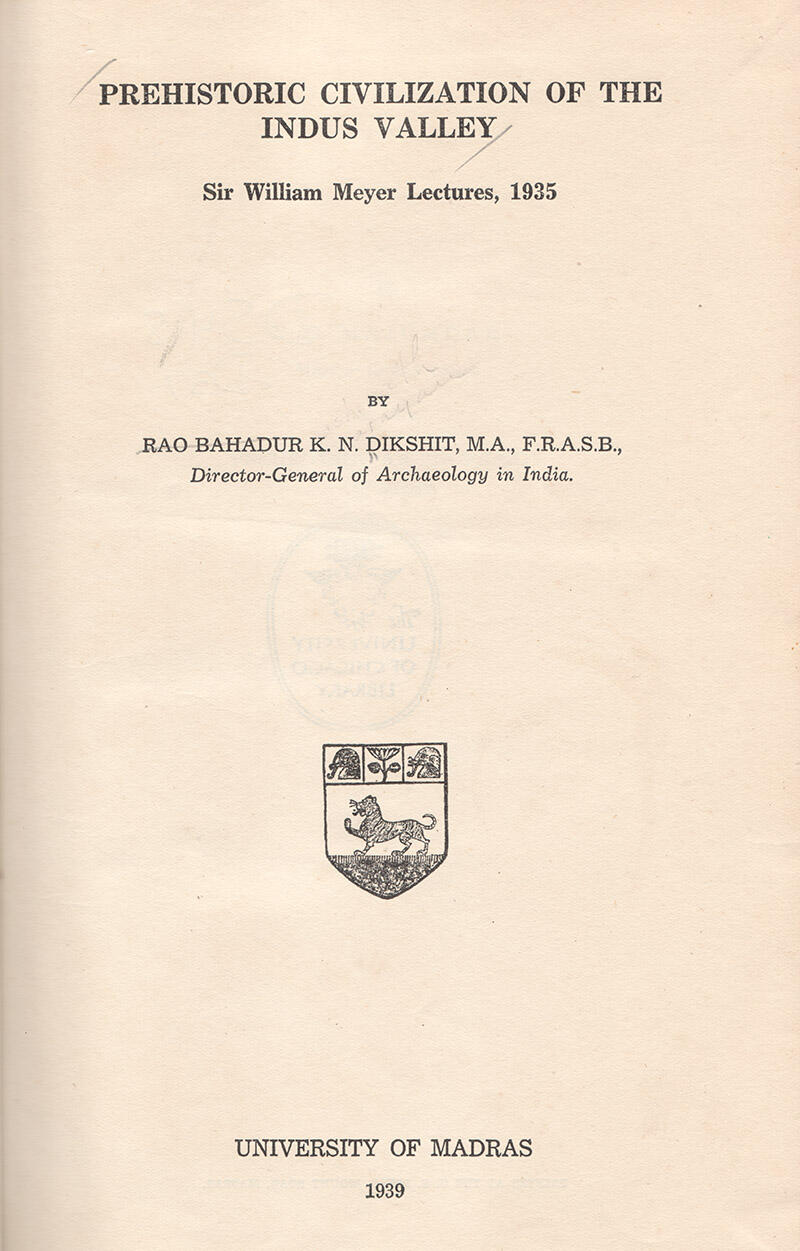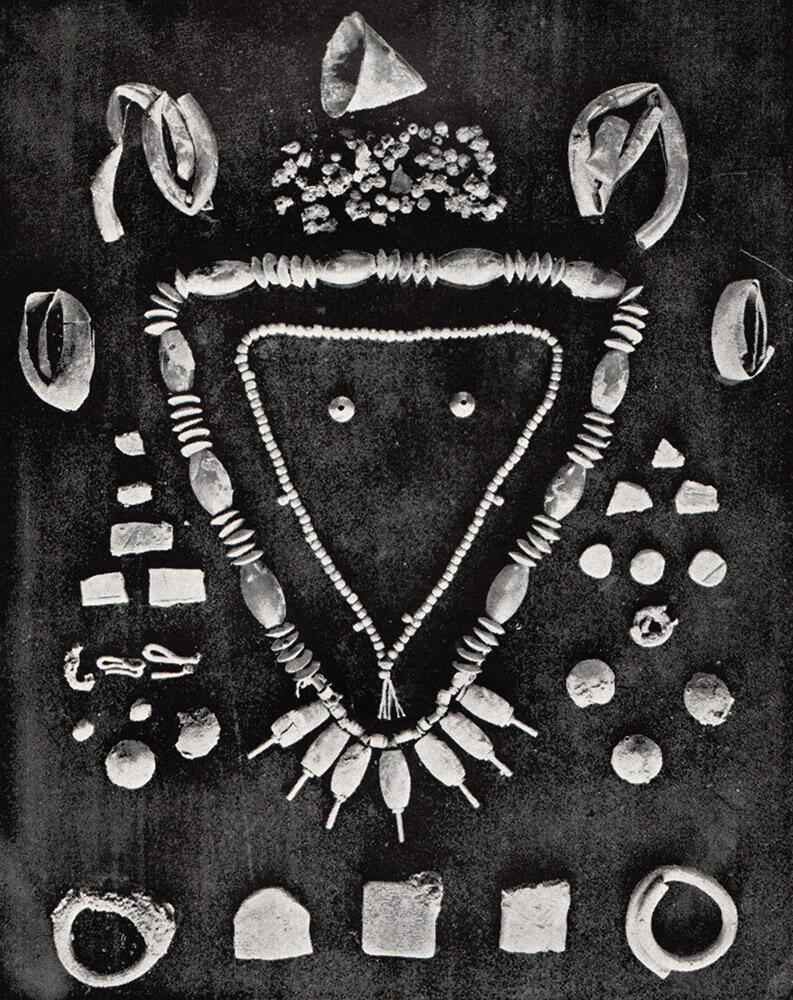These lectures at the University of Madras in 1935 by the archaeologist Rao Bahadur K. N. Dikshit is a little known but well-written and surprisingly relevant summary of what was known about the ancient Indus civilization based after the first 14 years of excavations at Harappa and Mohenjo-daro (1921-35). Inasmuch as the contributions of many Indian archaeologists in those early years are little described, this is not surprising. Fortunately modern digital platforms make instant, easy access to the concise, illustrated manuscript of Prehistoric Civilization of the Indus Valley easy and free to all.
The three talks are well worth a read for they help understand how perceptive and far-sighted many of these early Indian members of the Archaeological Survey of India (A.S.I.) were. How could they not be, given the qualifications and prizes candidates had to win to even be hired for but a handful of jobs? Dikshit, for example, as Nayanjot Lahiri writes in Finding Forgotten Cities, "studied at Deccan College, Poona, where he had won almost all the Sanskrit prizes at the university examination" (p. 347). He began his career in Bombay in 1914, and by 1924 was in charge of the A.S.I.'s Western Circle, and excavating at Mohenjo-daro, where the DK Area is named after his excavations. He was Director-General of the A.S.I. (1937-1944), only the second Indian to hold the post, immediately preceeding Sir Mortimer Wheeler.
Dikshit writes in Prehistoric Civilizations: "A bird’s eye view of the site of Mohenjodaro gives us an idea of conditions five thousand years ago. We find in the neighbourhood of the stupa which gave us the clue, a number of regularly laid out streets lined with houses. We also find another area in which there are houses with big halls and rectangular pillars to support the roof a peculiarity not found in most other places. In the higher site which was dug extensively, you can see easily the streets connected with one another by lanes. We also see another cross street which forms the present channel of communication between Mohenjodaro and the outside and which appears to be as old as the ancient city. The junction of these two streets has been called by some scholars as “The Oxford Circus of Mohenjodaro”. As will be seen, a very large portion of Mohenjodaro has yet to be excavated, for the total area which has so far been brought to light is not even a tenth of what clearly must have been the extent of the city" (p. 8-9).
His views on one of the most fascinating structures at Mohenjo-daro have not been improved upon: "The only instance in which bitumen (undoubtedly obtained from a long distance) is used in masonry in order to make it watertight, is in the construction of this Great Bath. It is apparent that the bath used to be filled with water at regular intervals from the three wells in the neighbourhood, and there are arrangements for carefully emptying the bath through a square hole in a comer into a passage whence it was carried through a culvert high enough to allow a man to pass through it. This establishment was thus very important and unique, and it is possible that the visitors to the main temple, which stood at a short distance from the Bath, used it for ceremonial purposes. The existence of a group of small bath rooms at a short distance of the Great Bath, each of which is provided with a stairway, probably leading to a cell above, indicates the existence of an order of holy men, who were required to perform ablutions very frequently" (p. 19).
Nor did he avoid commenting on the fact that there might have been hierarchies in those times, but is very careful not to jump to conclusions: "In Mohenjodaro itself the largest buildings that have been discovered measure 242' in length by 112' in breadth and another of slightly smaller dimensions. Each of these has several courtyards surrounded by living rooms, store rooms, etc., which indicate that they must have been in the occupation of a person holding high position and a large family and dependants. In the absence, however, of any distinctive features in the construction or size af buildings or rooms, it is not possible to say definitely whether it was the palace of of commercial magnate or a prince. In one area at Mohenjodaro a hall of considerable dimensions (85' square) with a roof supported by 20 brick piers arranged in four aisles is found. It is possible that this was used for some public purpose of the community such as religious congregation, as it is in the neighbourhood of the great bath and possibly the main temple underlying the Buddhist Stupa, but Dr. Mackay considers it to be a marketplace. At some places in Mohenjodaro, buildings with large rooms and strong floors having regular depressions sunk in the floor have been found, particularly at convenient corners of roads. In one case it has been supposed that large earthen jars rested on the floor over these sunken depressions and the building was a restaurant where liquor was served.
It is, however, more likely to have been a charitable watering place (modern Piao) as the tradition of founding free watering places is more in accordance with Indian custom and the requirements of the Indian climate than the establishment of a public tavern or restaurant" (pp. 21-22), even as he notes "In India, however, the average citizen of the great Indus cities appears to have enjoyed a greater measure of personal freedom and an equitable share of the amenities of life than his contemporaries in other countries" (p. 24) and continues in the same vein: "The cosmopolitan character of such a commercial city, which may be considered as a prototype of modem Karachi, explains why the skeletons found at Mohenjodaro have bees composed of so many different races, whereas the skulls from different ancient cemeteries in Egypt point to almost identical ethnic type. This heterogeneity of the population which may have been a source of strength in the flourishing period when every element attracted to the city by its wealth v/as absorbed may have later proved to be the cause of the disintegration of the civilization in its declining period. It is, however, a testimony to the general standards of equality that there was little in the exterior to distinguish the house of the commercial magnate or the ruling chief from that of the humble artisan or the ordinary citizen" (p. 25).
Nothing escapes his attention: "The large number of children’s toys and requisites such as feeding cups discovered in different materials, such as pottery, shell and ivory, indicate the existence of a widespread toy industry and the care of the people to provide their children with these amenities. The large number of pottery bulls and carts have been referred to above. Rattles in the shape of round balls with pellets inside generally decorated with painted lines are common. Quite a number of other animals, such as dogs, monkeys, birds, rhinoceroses, etc., are found. Some ingenious toys, such as bulls with a nodding head attached separately to the body, are known" (p. 29).
The third lecture deals with the Indus script, where he agrees with views that the unicorn figure found on most seals "is unlike any known animal and with the single horn must be considered as imaginary" (p. 44). There are a number of illustrations and diagrams at the end.
Tragically, he dedicated this volume, published four years after the lectures, to his good friend N.G. Majumdar, also of the A.S.I., another Gold Medalist (University of Calcutta, 1920) whom he describes as "Martyr to the cause of the Prehistoric Archaeology of Sind. d. 11-11-38," who was tragically killed by robbers at Mohenjo-daro who may, it is said, have mistaken him for a Britisher given the pith helmet he like all archaeologists at the time wore.




